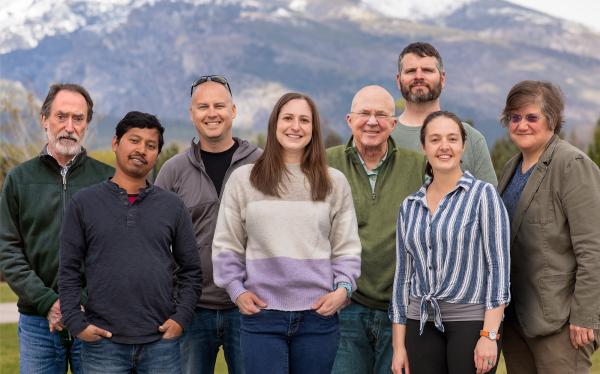Neuroimmunology Section
Established in 2008
Karin Peterson, Ph.D.
Chief, Neuroimmunology Section

Major Areas of Research
- Interaction of immune and nervous systems
- Neuropathogenesis of Orthobunyaviruses including La Crosse virus and Jamestown Canyon virus
- Neuropathogenesis of Zika virus
- Mechanisms of virus-induced neuronal damage
- Immune responses in the CNS
Program Description
A number of human viruses have the potential to infect the central nervous system and cause serious encephalitic disease or death. Virus-induced neuronal death can occur either through direct infection of neurons or via indirect mechanisms such as recruitment of inflammatory cells that cause pathological damage. The Neuroimmunology Section studies multiple encephalitic viruses to gain a better insight into the interactions between the immune response to virus infection and the development of neurological disease. A major goal of our laboratory is to elucidate the major pathways that mediate neuropathogenesis so that rationally designed therapeutics may be developed to intervene in the disease process. This includes examining the factors that mediate virus entry into the CNS, the recruitment of inflammatory cells to the brain, and the influence of these cells on CNS damage, as well as direct damage of neurons by virus infection.
Virus Entry in the CNS
Our primary work has been on the California Serogroup (CSG) of orthobunyaviruses, an emerging group of mosquito-borne viruses that can invade the CNS and cause severe neurological disease. The most notable of the CSG viruses, La Crosse virus (LACV), is the primary causes of pediatric arboviral encephalitis in the United States. Over 80% of reported neurological disease cases caused by LACV occur in children, while adults only develop a mild febrile illness. We established a mouse model of LACV infection where young mice under 4 weeks of age develop severe neurological disease, but adult mice do not. Our studies have found that key components of both the innate (Taylor, Woods et al. J. Virol. 2014) and adaptive (Winkler et al. J. Neuroinflam. 2017) immune responses regulate protection in adults and that these immune responses are limited in young mice. The inability of young mice to control virus replication results in viremia that leads to neuroinvasion. We found that specific regions of the blood brain barrier (BBB), particularly in the olfactory bulb and tract, were more susceptible to virus-induced vascular leakage resulting in LACV entry into the brain in these young mice (Winkler et al. Acta Neuropath. 2015). Furthermore, brain capillary endothelial cells (BCECs) from young mice were more susceptible to virus infection and damage than BCECs from adult mice (Basu et al. J. Neuroinflam. 2021). We are currently examining the differences in gene expression between young and adult BCECs to identify proteins that may regulate virus-induced damage of the BBB.
Neuronal Damage
A key factor in viral encephalitis once the virus has entered the CNS is the infection and death of neurons. Our studies have demonstrated that the innate immune response in neurons contributes to virus-mediated neuronal apoptosis. We have identified one of the main mediators of innate immune-mediated damage, a toll-like receptor (TLR)-associated protein named SARM1 (Mukherjee et al., Immunity 2013). Induction of SARM1 in neurons affects mitochondrial localization/damage leading to neuronal death in vitro and in vivo (Mukherjee, Winkler, Taylor et al. J Immunology 2015). More recently, in a collaboration with Dr. Cathryn Haigh’s group at RML, we utilized induced pluripotent stem cell (iPSCs) generated human cerebral organoids (hCOs) to examine how neuronal development affected the response to LACV infection. We found that committed neurons were more likely than neural progenitors to undergo apoptosis, even though both cell populations were infected with LACV (Winkler et al. J. Neuroinflammation 2019). Single cell analysis of these hCOs showed reduced interferon-stimulated gene (ISG) response in the committed neurons following LACV infection compared to the other neuronal populations in the hCOs. We are currently looking at specific ISGs to determine how they influence neuronal infection and death in the hCO model.
Comparison of California Serogroup (CSG) Viruses
Several members of the CSG viruses cause human viral encephalitis, although the relative number of yearly cases differ dramatically. To examine whether the incidence of cases was associated more with human infection prevalence versus viral pathogenesis, we compared the pathogenesis of the five most known viruses in our mouse model. We found that similar to human neurological disease cases, LACV was the most pathogenic, whereas CSG viruses that only caused sporadic disease in humans were less virulent in mice (Evans et al. Emerg. Inf. Dis. 2019; Evans and Peterson, Viruses 2019). Interestingly, Inkoo virus (INKV) - the least neuropathogenic of these viruses - was able gain access to the CNS but had low neurovirulence (Evans et al. PLoS Path. 2022). We are currently investigating the mechanisms that regulate differences in pathogenesis between these CSG viruses.
Therapeutics
The lack of useful therapeutics is also a major barrier for the treatment of viral encephalitis cases including CSG viruses. We recently identified a potential therapeutic, Rottlerin (RTL), which we found inhibited LACV replication in neurons and hCOs (Ojha et al. Nature Micro. 2021). RTL also inhibited pathogenesis in the mouse model of LACV, even when treatment was delayed until virus was present in the CNS. We are currently studying the ability of RTL to inhibit other RNA viruses including Zika virus (ZIKV) and SARS-CoV-2.
Development of a Vertical Transmission Model for Zika Virus (ZIKV)
Following the outbreak of ZIKV-induced microcephaly in 2015, we collaborated with multiple investigators on developing animal models to study ZIKV pathogenesis. We identified key components of the immune response to ZIKV (Winkler et al. J. Immunol. 2017) and developed vertical transmission mouse model of ZIKV where fetuses are infected in utero (Winkler et al. Immunology 2018; Winkler et al. Sci. Rep. 2017). We found that placental myeloid cells from the mother protected against vertical transmission of virus (Winkler et al. J. Immunology 2020). We found specific changes in brain structure and neuronal maturation in the brain post-birth of pups infected with ZIKV in utero (Winkler et al. Acta Neuropath Comm 2022) and are investigating mechanisms of virus damage as well as potential therapeutic treatments.
Biography
Education
Ph.D., 1998, University of Missouri Medical School
Karin Peterson received her Ph.D. in microbiology and immunology in 1998 from the University of Missouri Medical School, where she studied autoimmunity and the activation of self-reactive T cells. She then went to Rocky Mountain Laboratories (RML) in 1998 as a postdoctoral fellow in the Laboratory of Persistent Viral Diseases (now Laboratory of Neurological Infections and Immunity) and applied her skills in immunology toward understanding the mechanisms that control the immune response to retrovirus infection. During this time, she became interested in the immune responses to virus infections in the central nervous system (CNS). In 2004, Dr. Peterson accepted a position as an assistant professor at Louisiana State University School of Veterinary Medicine, where she furthered her studies on viral pathogenesis in the CNS and also taught classes in immunology and virology. In 2008, she returned to RML as a tenure-track investigator to study the innate immune responses in the CNS and their role in viral pathogenesis. She was tenured in 2016 and became a senior investigator and chief of the Neuroimmunology Section.
Selected Publications
Winkler CW, Clancy CS, Rosenke R, Peterson KE. Zika virus vertical transmission in interferon receptor1-antagonized Rag1-/- mice results in postnatal brain abnormalities and clinical disease. Acta Neuropathol Commun. 2022 Apr 4;10(1):46.
Evans AB, Winkler CW, Peterson KE. Differences in neuroinvasion and protective innate immune pathways between encephalitic California Serogroup orthobunyaviruses. PLoS Pathog. 2022 Mar 4;18(3):e1010384.
Ojha D, Winkler CW, Leung JM, Woods TA, Chen CZ, Nair V, Taylor K, Yeh CD, Tawa GJ, Larson CL, Zheng W, Haigh CL, Peterson KE. Rottlerin inhibits La Crosse virus-induced encephalitis in mice and blocks release of replicating virus from the Golgi body in neurons. Nat Microbiol. 2021 Nov;6(11):1398-1409.
Winkler CW, Woods TA, Groveman BR, Carmody AB, Speranza EE, Martens CA, Best SM, Haigh CL, Peterson KE. Neuronal maturation reduces the type I IFN response to orthobunyavirus infection and leads to increased apoptosis of human neurons. J Neuroinflammation. 2019 Nov 18;16(1):229.
Evans AB, Winkler CW, Peterson KE. Differences in Neuropathogenesis of Encephalitic California Serogroup Viruses. Emerg Infect Dis. 2019 Apr;25(4):728-738.
Winkler CW, Race B, Phillips K, Peterson KE. Capillaries in the olfactory bulb but not the cortex are highly susceptible to virus-induced vascular leak and promote viral neuroinvasion. Acta Neuropathol. 2015 Aug;130(2):233-45.
Research Group

Lab members of the NeuroImmunology Section. From left to right: Tyson Woods, Stephen Johnson, Saurav Rout, Rahul Basu, Clayton Winkler, Durbadal Ojha, Paul Policastro, Alyssa Evans and Karin Peterson

